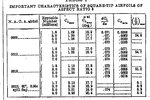delcyros
Tech Sergeant
The Jumo 004B's max output is 8.8kN (1,980 lbft), and the Me-262 has two of them !
The max output of the Vampire FB.1's Goblin 1 is 9.3 kN (2,100 lbft)!
Actually, the Jumo-004B3/4 were the only models rated to 890 Kp thrust, the B-2 was limited to 840 Kp and the B-0/B-1 rated to 820 Kp, respectively. By 1945, the vast majority of engines were Jumo-004B3/4. Only the Spider-Cap prototype hat 2.100 lbs rated H-1A´s, The Vampire F-I (there was no FB-I) was serially equipped with Goblin-I rated to 2.700 to 2.770 lbs, while using a more sophisticated mark rated to 3.100 lbs installed from the 41st serial plane onwards.
You are comparing apples with oranges. The FB-5 is a heavier fighter-bomber variant and in this condition (no fuel, no ammo, no loads) neither plane will be able to take off. Comparisons are usually placed at normal (full combat load), occassionally at overloaded fighter configuration in order to reflect operational conditions, both of which place the Me-262 at a slight disadvantage.The Me-262's empty weight is 3,800 kg, the Vampire's empty weight is 3,300 kg, so thats a power-loading of 215 kg/kN vs 314 kg/kN respectively. It's no wonder that the Me-262 is considerably faster at 870 km/h, and climbs faster at 3,900 ft/min, despite being a larger a/c. (The Vampire FB.5 with a 13.8 kN engine climbs at 4,500 ft/min and isn't even as fast at 866 km/h)
No claims, just proofs. Unlike You, I have access to the profiles in question. And your data don´t contradict mine (NACA 00011 is semi-symetrical).And as to the airfoils, again you seem to just be making up stuff and then base your wild claims on it.
The official airfoil thickness ratio of the Me-262 is 11% at the root and 9% at the tips. The airfoil design used was the NACA 00011-0.825-35 NACA 00009-1.1-40.
The Vampire's airfoil thickness ratio is 14% at the root and 9% at the tip, not hat different from the Me-262. The airfoil type used was the EC1240/0640 EC1240/0640.
No. My Cl-max figures do come from drag/lift profiles, provided by profile software. Thickness ratio is not the decisive aspect in airfoil performances. If you have access to ordinates of the profiles (to be obtained in the net) and Mark Drelas or other software (profile 2.0 is excellent) You will find my values for Cl-max substantiated. Don´t forget to use the profile for the correct reynold-numbers! Each airfoil has different profiles for different RE-numbers.And as to your CLmax figures, well they are based solely on thickness ratio, which is ridiculous cause you can't even begin to figure out CLmax by just using thickness ratios for crying out loud! First of all there's no std. increase in Clmax with an increase in thickness ratio, infact Clmax may drop with an increase in thickness ratio depending on the airfoil type, so you can forget that those ridiculous Clmax figures you posted !
That´s pretty irrelevant as neither the Me-262 nor the Vampire had this airfoil.For example a NACA 23000 series airfoil (Known for its high CLmax figures) of 9 - 16% thickness ratio has a CLmax of 1.58 to 1.64 ! That's a lot more than usual. But as the thickness ratio increases to 18% the CLmax actually starts to drop.
Disagreed. You are free to verify this on Your own, my friend. Assuming that both planes have the SAME AIRFOIL is a substantial and in this case basic error.So like I said the Me-262 holds a lift advantage of ~25% pr. surface area, giving it a lower lift-loading, and it also holds a good advantage in power to weight ratio. (3,800 kg / 21.7)*0.75 = 131.33 kg/m^2
(3,300 kg / 24.3) = 135.8 kg/m^2
Yes. Agreed 100%.The H.1 was initially tested at 2300lbf which was then increased to 2700lbf in the Goblin I and 3000lbf in the Goblin II and then 3100lbf in the Goblin III.
There is only a slight difference in speed and performance between Vampire FIII and Vampire FB-V. The Vampire F-I using Goblin-I (2700lbs) is slightly lower rated but in no ways inferior as pointed out above at any condition other than "almost empty".The Vampire FB.5 is the one which climbs at 4,500 ft/min and has a top speed of 866 km/h, NOT the Vampire Mk.I which is the only version which saw service in 45. Do you even know when the different versions saw service??
Anthony Kay rates the Jumo-004D4 (of which none ever equipped Me-262A´s to see combat) with 930Kp thrust (9.1KN). The Jumo-004E without reheat was rated to 1000 Kp (9.8KN) thrust, but this engine, too was about to be produced.Also there's nothing wrong with using empty weights, esp. since it's only natural that a more powerful a/c consumes more fuel. Also the use of the Jumo 004D would've not only decreased fuel consumption but also increased power to 10.3 kN.


